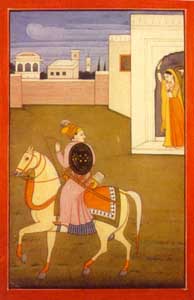FUNDAMENTALS OF RAG
The rag is the most important concept that any student of Indian music should understand. The Hindi/Urdu word “rag” is derived from the Sanskrit “raga” which means “colour, or passion” (Apte 1987). It is linked to the Sanskrit word “ranj” which means “to colour” (Apte 1987). Therefore rag may be thought of as an acoustic method of colouring the mind of the listener with an emotion. This is fine as a general concept but what is it musically? It is not a tune, melody, scale, mode, or any concept for which an English word exists. It is instead a combination of different characteristics. It is these characteristics which define the rag. Here are the characteristics.

There must be the notes of the rag. They are called the swar. This concept is similar to the Western solfege.
There must also be a modal structure. This is called that in North Indian music and mela in carnatic music.
There is also the jati. Jati is the number of notes used in the rag.
There must also be the ascending and descending structure. This is called arohana /avarohana.
Another characteristic is that the various notes do not have the same level of significance. Some are important and others less so. The important notes are called vadi and samavadi
There are often characteristic movements to the rag. This is called either pakad or swarup.
In addition to the main characteristics of rag, there are some other less important ones. For instance rags have traditionally been attributed to particular times of the day. They have also been anthropomorphize into families of male and female rags (raga, ragini, putra raga, etc.). There is a tendency to downgrade the importance of these aspects due to their irrational and unscientific nature.
Here is a list of rags. Select the desired rag and it will take you to a detailed description.
* Ahir Bhairav
* Asavari
* Bahar
* Bhairav
* Bhairavi
* Bhimpalasi
* Bhupali
* Bhupeshwari
* Bihag
* Bilawal
* Chandrakauns
* Darbari Kanada
* Desh
* Deshkar
* Durga
* Gujari Todi
* Kafi
* Kalingada
* Kalyan
* Khammaj
* Lalit
* Malkauns
* Marwa
* Mian-ki-Todi
* Purvi
* Tilak Kamod
Instruments Used To Play Rags
* Bansuri
* Dilruba
* Esraj
* Gotuvadyam
* Harmonium
* Jal Tarang
* Mayuri Vina
* Nadaswaram
* Rabab (Kabuli Rabab)
* Rudra Vina
* Santur
* Sarangi
* Saraswati Vina (South Indian Vina)
* Sarod
* Seni Rabab
* Shehnai
* Sitar
* Surbahar
* Swarabat (Swaragat)
* Tabla Tarang
* Vichitra Vina
* Violin


